(All rights belong to their owners. Images used here for review purposes only.)
Legend of Zelda: Kamigami no Triforce 2 (Nintendo, 2013)
In the U.S., this game was titled "A Link Between 2 Worlds". In Japan, it's "Triforce of the Gods 2." It was intended for the Nintendo 3DS. I picked it up used for about 2,500 yen ($22 USD). After finishing Mask of Majora in January, I was burned out on the idea of the Zelda games, and most games in general. Then, in March, I was hoping to get Ocarina of Time, which is kind of a prequel. However, all 5 copies of Ocarina had disappeared from the Book Off nearest me, so I went down to the second store, a 40 minute walk the other side of the main train station, where all they had was Kamigami and Majora. I got Kamigami at that time, and a week later I visited the Book Off in Minami Kagoshima, a 30 minute tram ride away. Although the third store has the largest selection of used 3DS games, they had the fewest of the Zelda games of the shops in Kagoshima, and they didn't have Ocarina, either. I get the feeling Book Off sent all their copies to a branch in some other city. Sigh. So, I settled for getting Kamigami.
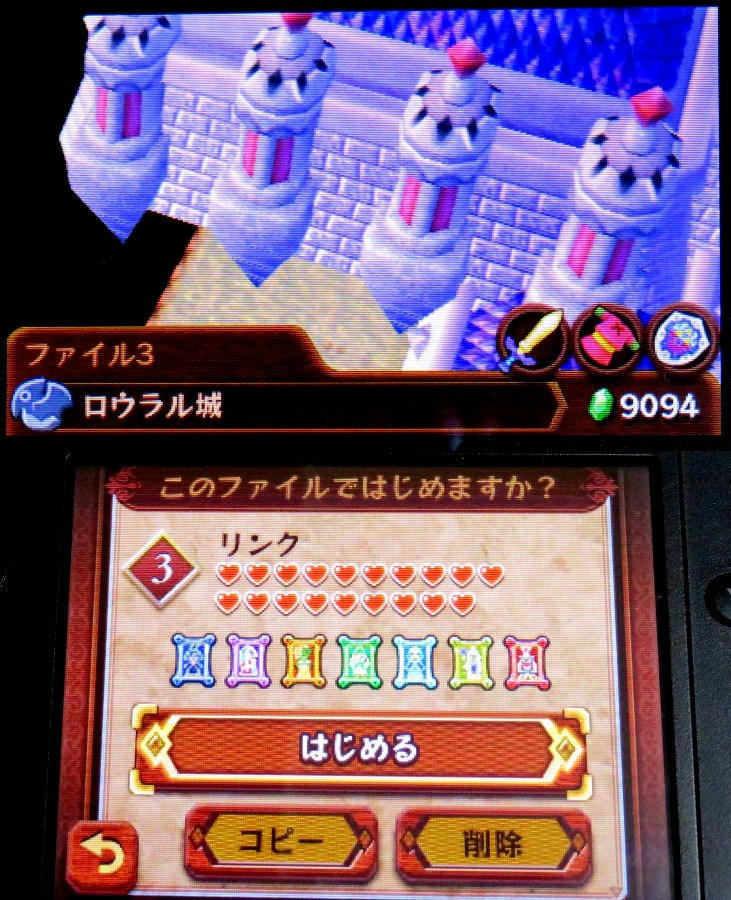
(The game load screen, with a flyover of the castle in the background, and the game status on the load screen. I've got 19 of 20 hearts, and I've recovered all 7 sage paintings.)
I first played the first Legend of Zelda game on the Super Famicom system in the mid-90's, and then again later when I found a free copy of the Gameboy Advance cart lying in a parking lot. I have fond memories of that game, and I'd been thinking about it as I was planning on getting Ocarina. So, I was pretty amused when I discovered that Kamigami is pretty much a reworking of that original Zelda game for the SFC. The idea of Link switching between the light and dark worlds is still intact, as well as his being able to find an empty bottle in the moat under the castle drawbridge. But just about everything else has been update or reworked.
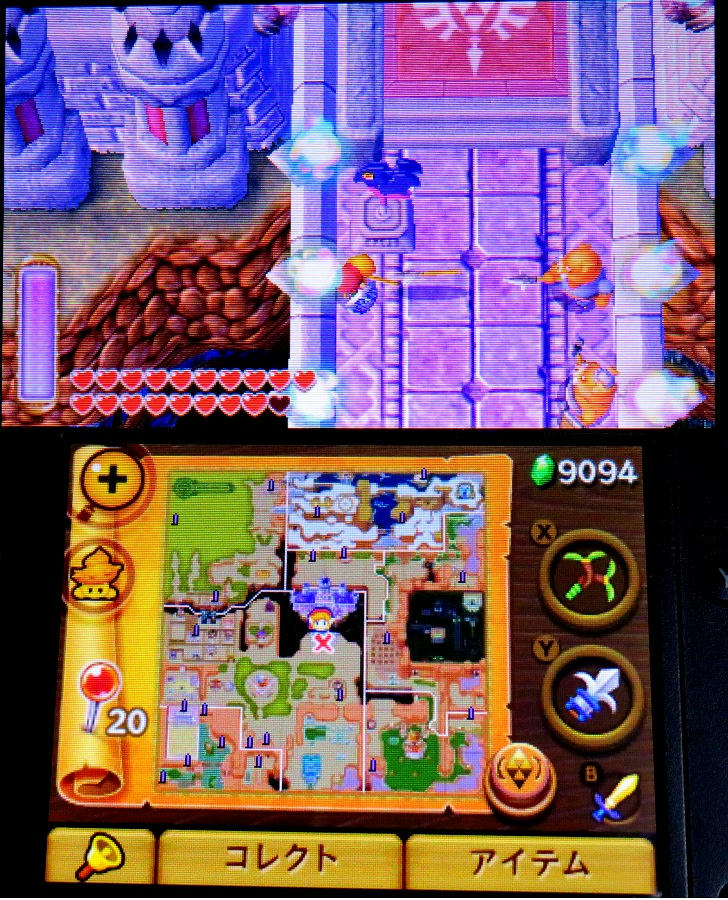
(Visiting the castle save point (a weather vane), and the field map on the lower screen. I've got the tornado rod assigned to the X button, and the hookshot to the Y button.)
Story: Link is one of two sons of a blacksmith and his wife, the lazier of the two. One morning, he's summoned to the smithy, where the popinjay captain of the guards is having a new sword made. The captain leaves, forgetting the sword, and Link is tasked with taking it to the castle. But, the captain is at the Sanctuary/church behind the castle, and when Link gets there, he hears a scream from within the building. Inside, the captain has been turned into graffiti on the church wall, and a crazed magic-wielding artist is busy turning the head sister into a framed painting that he absconds with. Back at Link's house, a strange guy in a rabbit suit drops by and asks for a place to stay for a while. Link says "yes" and receives a wristband in return. In the castle, Zelda gives Link a protective amulet, then the artist, Yuga, shows up and turns her into a painting too, and attempts to convert Link into graffiti. But, the rabbit-guy's wristband turns out to have the power to let Link merge in and out of walls as a painting, and thus his adventure begins.
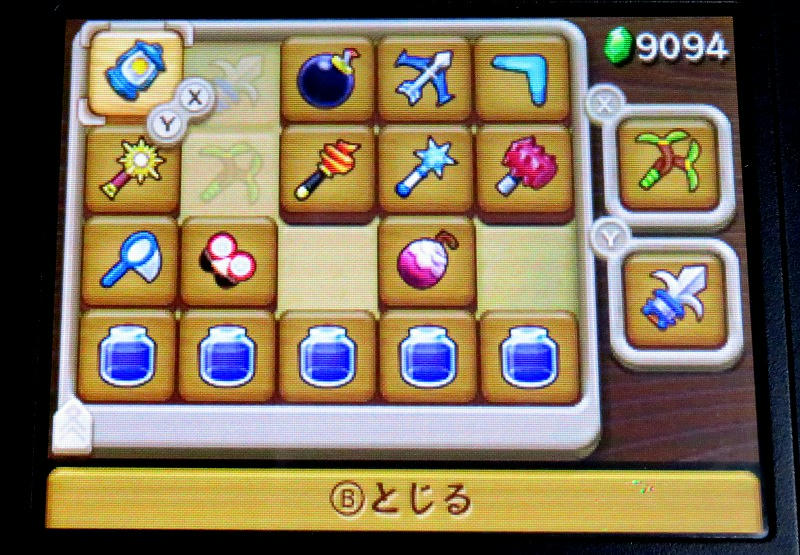
(The item select screen. All of the tools have been upgraded. There are only two empty slots left. One is for a replenishable seed that zaps enemies for a few seconds, but you can only carry one at a time. The other is for the Bow of Light, which you don't get until the end of the final boss fight.)
Yuga is after the seven sages of the light world, Hyrule, presumably as a way to bring the Triforce to the dark world, Lorule. When he gets them all, he turns into a demon and tries to destroy Link again. This time, though, Link is saved by the princess of Hyrule, Hilda, who begs him to become stronger and defeat Yuga. From this point, the game is divided into 2 sets of quests and dungeons. The first is to visit 3 dungeons in Hyrule to get the Pendants of Strength, Courage and Wisdom, which lets him gain the Master Sword. The second follows the ability to use the painting skill to locate fissures scattered around Hyrule to let him travel to Lorule, and then rescue the seven sages, which are in one dungeon each. The last two dungeons are a 50-floor tower as a mini-game, and the Lorule Castle leading to the final boss battle with Yuga. As with all Zelda games, you need various tools to solve all the puzzles, and you're trying to get 28 heart pieces to extend your health when you fight battles (4 pieces = 1 full heart. You start with 3 hearts and you get an extra 1 full heart for beating each of the dungeon bosses for a grand total of 20 hearts possible.) One thing that is new here, though, is that 8 of the tools aren't hidden in the dungeons. Instead, you rent them from the rabbit-guy living in your house, and later in the game you can buy them outright. Renting is cheaper, which is good when you're starting out with no money, but you lose the rented tools if you fall in battle, and you have to pay to rent them again. Buying is more expensive but you don't lose the tools if you die, and you can only upgrade the tools you own. These include the bomb, the hookshot, the boomerang, the hammer, and the tornado, sand, fire and ice rods. The other tools, like the bee net, the lantern and the empty bottles (required for carrying bees, healing faeries and health potions) are found scattered throughout the game.
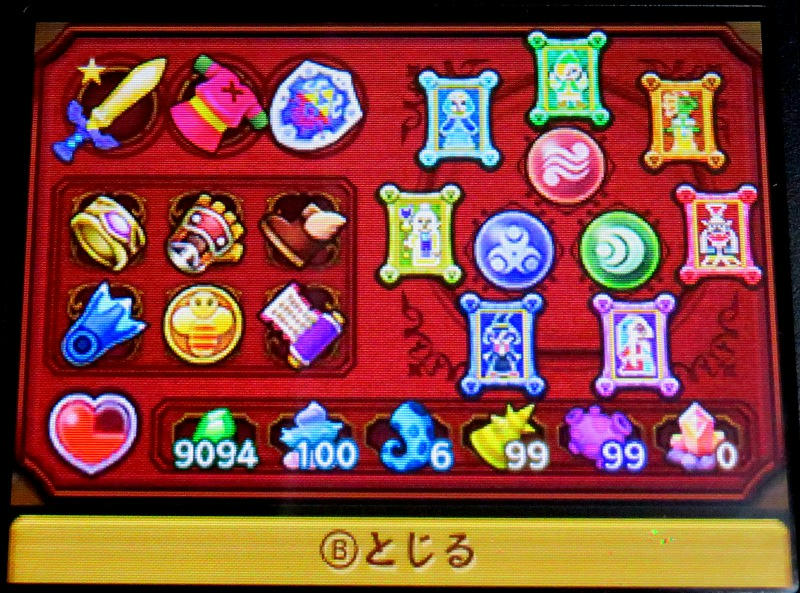
(The collection display screen. The monster parts at the bottom turned out to be mostly unnecessary. They're used for making the healing and attack potions that you buy from a witch, but only the blue full-health potion was worth obtaining, since you need empty bottles for holding faeries, potions, and bees, and you really need the faeries during the majority of the game, and the blue potions for the final boss battle.)
Money is not really a problem. You get rupees from monster drops, cutting grass, and treasure chests. Additionally, there is a bee collector in the village that gives you the bee net if you have an empty bottle, and 50 rupees for every bee you bring back. There's a rare golden bee, that actually wasn't that rare - I found 5 of them in the two times I ran through the game - that the bee collector will pay 300 rupees for, plus he gives you a bee badge for the first golden bee you turn in, that keeps bees from attacking you. There's a large section of grass nearby that you can mow down for finding rupees and bees. If you have the Master Sword with its wind attack when you're at full health, and 5 empty bottles, you can easily amass 300 rupees every 3-5 minutes with simple churning and bee collection. Buying the rods from the rabbit guy are 1,200 rupees each, and the other tools are 800 rupees each, although he gives you a 50% discount on the first tool you buy (logic dictates it should be one of the four rods). Simple math shows you're going to need about 7,000 rupees for all the tools, then it's 200 rupees per bottle of full health potion, and then maybe another 1,000 - 2,000 rupees to play all of the mini games that reward you with heart pieces. The game stats screen after I finished the game the first time said that I'd found 33,000 rupees total, even though the game caps you at 9,999 rupees max. Like I say, money is not an issue.
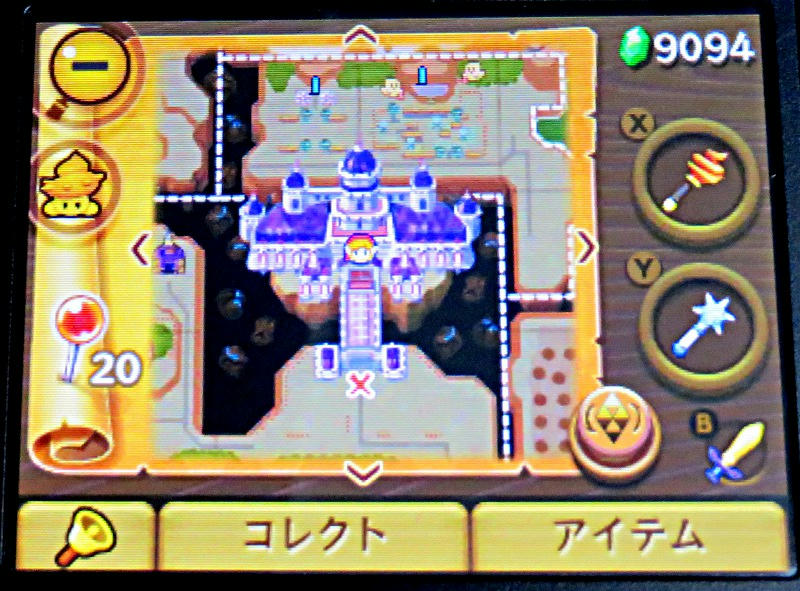
(Main field map.)
One other departure from the original Zelda game is the introduction of the Maiamais. These are little snail-like creatures found in both the light and dark worlds. The octopus mother Maiamai lives in a cave near Link's house. She asks you to bring back all 100 of her "junior me's," and for every 10 you recover, she upgrades one of your tools. This makes the tool stronger and cover a larger damage area. The boomerang was absolutely useless in this game, but the hookshot and tornado rod were good for stunning enemies, and the ice and fire rods were good for damaging the more powerful enemies later in the game. The other tools were ignorable, except where certain puzzles were designed for them; such as switches and cracked walls only approachable by the bomb tool.
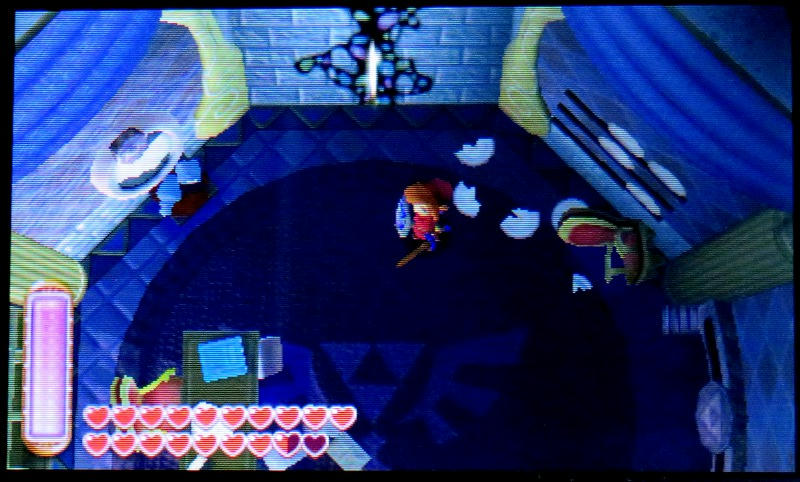
(In the castle. The white crack in the north wall is a fissure that lets you go between Hyrule and Lorule.)
Overall, Kamigami is a mixed game. There were quite a few mini games, and I hate mini games. Unfortunately, I had to complete them twice for obtaining the heart pieces. Although, I finally gave up on two of them (avoiding being hit by chickens for 6 minutes in a dodge game, and running from one end of Hyrule to the other in 65 seconds in a race against the clock. The hardest level of the dodge game just gives you free healing if you keep returning to the village, and the race game gives you a heart piece. I didn't need either reward to finish the game.) So, the mini games were frustrating, as were some of the boss fights. But the rest of the game was fun. I liked exploring both worlds, and solving some of the puzzles. The twist ending leading up to the final fight with Yuga was good too. But, you really do need a good walkthrough. I never would have been able to complete the game otherwise, it's that hard. The walkthrough mentioned two extra items that you get by playing the hard mode (in the English version, it's called "Hero mode"). One is a diary found in Link's empty house in the dark world, and the other is a modified credits scene at the end of the end credits roll. Hard mode is unlocked when you finish the game in normal mode. The only difference between the two is that the enemies deal twice as much damage in hard mode. Otherwise, they're the same game. If I'd known that the modified ending scene was just one little 3-second piece, I wouldn't have bother playing a second time. I still managed to win it again, but the final battle against Yuga was almost impossible for me to clear in hard mode. Still, I've done everything I want in the game in both modes, and I can put the game away knowing there's no reason for me to play it anymore now.
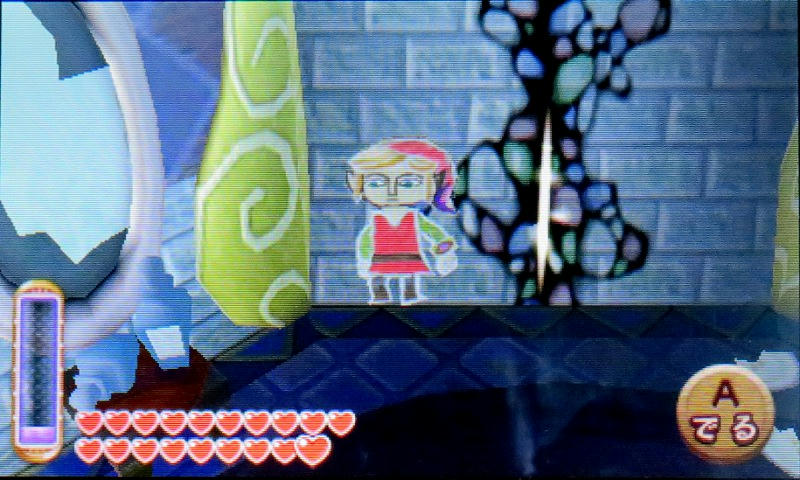
(Link using the bracelet to merge into the wall to use the fissure. The purple gauge to the left of the screen is how much magic you've got left. If the gauge goes to zero, you pop out of the wall. Magic is also consumed when you use tools like the bombs and the tornado rod. But it recovers automatically over time.)
In summary, the artwork is classic Zelda, the storyline and plot are creative, and the puzzles are challenging. You have to do a lot of fighting, which doesn't net you much (just money and monster part item drops), but the alternative is to run away from the enemy all the time, and that's no fun either. The animation is good, although there aren't any cutscenes this time. I didn't bother listening to the music, so I can't comment on that. But, I can recommend Kamigami based on the story and dungeon challenges. I give the game a solid B+. It's right up there with the original Zelda. It can't be compared to Mask of Majora, though, because they're completely different approaches to the Zelda universe.
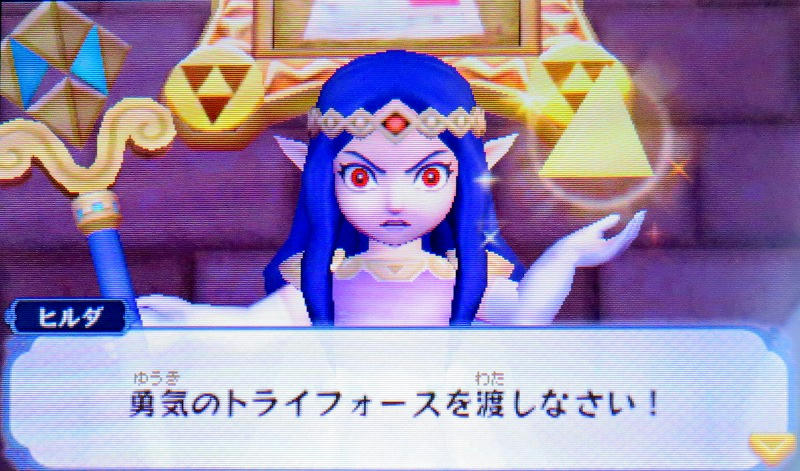
Buy it. Now.
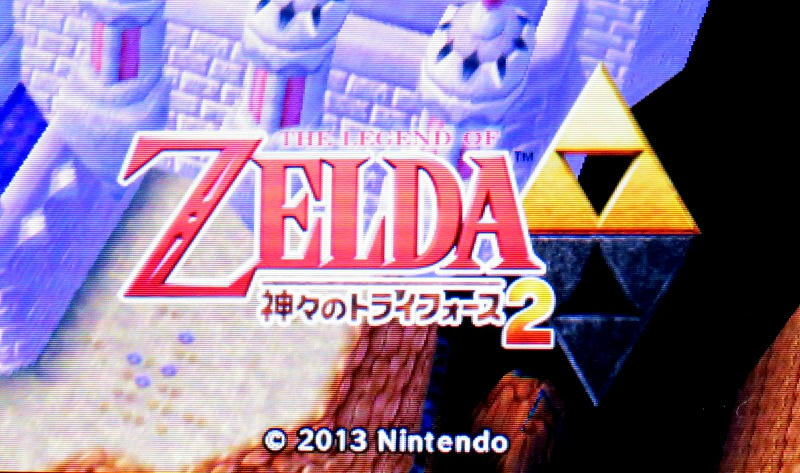




No comments:
Post a Comment